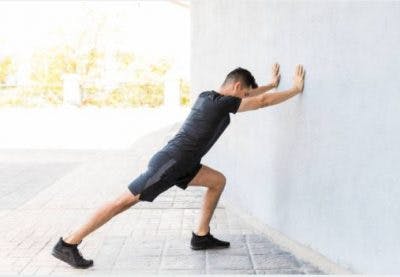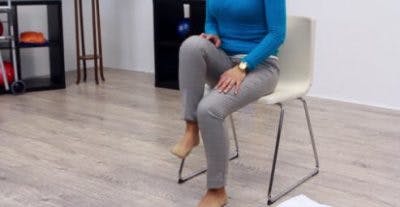No products in the cart.
No products in the cart.
No products in the cart.
No products in the cart.
Home » Neurological Recovery Blog » Cerebral Palsy » Simple & Effective Leg Exercises for Cerebral Palsy
Last updated on July 23, 2019

Wondering what the best leg exercises for individuals with cerebral palsy are?
Cerebral palsy can result in mild to severe motor impairment.
Some people will have motor impairment in their legs, only on one side, or only in their upper bodies. Everyone experiences cerebral palsy differently.
This article will provide several leg exercises for cerebral palsy patients and suggest adjustments you can make to accommodate to your specific motor impairment.
Passive range of motion exercises are performed by a caregiver or physical therapist moving your joints through a pain-free range of motion.
You don’t need to have active movement in your arms or legs to participate in passive exercises.
Passive range of motion exercises are beneficial for individuals with severe cerebral palsy who don’t yet have the ability to control their movements.
Benefits of passive exercise include:
Lay down flat and have your caregiver lift your leg and bend it towards the chest.
Hold for a few seconds and then straighten the leg back out. Repeat 3-5 times and then switch to the other leg.
Just like the previous exercise, lay down flat and have your caregiver bend one knee.
With one hand on the thigh and the other below the calf, gently move the knee in large circles so that it is circling around the hip joint.
After a few rotations, switch directions.
The caregiver should hold the bottom of the foot with one hand and the ankle with the other hand.
Stabilize the ankle and rotate the foot clockwise and counterclockwise.
Lay down flat and have your caregiver gently pull one leg out to the side and then bring it back in.
The leg should not be overly extended, just until the caregiver can feel the body’s natural resistance.
Want 19 pages of CP recovery tips in PDF form? Click here to download our free illustrated ebook now (link opens a pop up for uninterrupted reading)
Over 75% of cerebral palsy patients have spastic cerebral palsy, which is characterized by constantly high muscle tone.
The most effective leg stretches for cerebral palsy patients are going to work on gently lengthening tight muscles.
If you have limited leg control but full upper body control, we highly recommend using a resistance band to stretch your legs.
Place the band under your foot or any part of your leg and then pull with your arm to maneuver and stretch it. Pull gently and hold the stretch for 15-20 seconds.
Next, we’ll go over some more active forms of stretching for those that have a bit more leg control.

Make sure that you have something to lean against (i.e. a wall, a chair, etc.) to help keep you balanced.
Place one foot a step behind you and then slowly bring your heel down.
To provide a deeper stretch, bring your leg back further. To make it easier, bring your leg closer to the rest of your body.

Sit with your knees bent and the bottoms of your feet pressed together
Place your hands over your feet and then move your upper body forward, towards the feet.
You should feel a stretch in the insides of your thighs.
Keep your back straight and bend from the hip.
To make this stretch more challenging, bring the feet closer towards your body.
To make this stretch easier, move the feet further away from the body.

Sit on the floor with one leg straight and the other bent to the side so that the bottom of the foot is touching the inner thigh of the opposite leg.
Extend your arms out, reach towards the foot of the straight leg, and then hold.
You want to keep your legs strong to maintain blood flow and flexibility.
To make any of these leg exercises more challenging, consider wearing weighted cuffs to add resistance.
Lay down with one leg bent and the sole of your foot against the floor.
Keeping the other leg straight, slowly raise it up, hold, and then bring it back down.
To make this exercise more challenging, keep the foot in the air even when it is lowered close to the ground, but not touching the floor.

For the next exercise, sit at the edge of your seat and alternate lifting your feet off the floor.
To make it more challenging, lift your feet higher.
When you have decreased control in your legs, walking can be challenging.
You have you sustain the weight of your body, shift your weight from side to side, and keep a steady pace.
Additionally, many children with cerebral palsy develop abnormal gait patterns due to spasticity, so developing ways to reduce spasticity and then promoting correct walking form is essential.

Water has 2 properties that make it ideal for muscle strengthening.
Buoyancy is what makes you feel lighter and keeps you afloat. It helps you practice walking without all your weight pressing down on your joints. Therefore, you can focus on perfecting your form and then transition out of the water.
Viscosity is what makes it difficult to walk quickly underwater. It helps strengthen the muscles by making you push against the water’s resistance.

Ever noticed how much more tiring it is to walk on sand?
Sand is loose, so every time you take a step, the pressure causes the surface beneath you to move around.
In other words, more energy is required to walk on sand because the surface is less stable.

Walking on any sort of incline (like a flight of stairs or a hill) is always going to require more energy because you have to work against gravity and lift yourself up.
The steeper the incline, the more energy you have to use for each step.
Being physically active may be more difficult and exercises may take longer for people with cerebral palsy, but movement promotes flexibility.
Neuroplasticity is the brain’s ability to rewire itself and adapt. When you regularly repeat an exercise, neuroplasticity is stimulated, and neurons fire along new pathways.
The more you stimulate neuroplasticity, the easier an exercise will become.
Remember, any movement is better than no movement, and every little bit of practice counts. Good luck!

Get our free 19-page PDF full of helpful tips for cerebral palsy by signing up below! If you liked this article, you’ll LOVE our free ebook.
When you sign up, you’ll also receive our popular emails that share more tips for life with cerebral palsy — you can opt out anytime.
We will never sell your email address, and we never spam. That we promise.


At Flint Rehab, we understand that doing physical therapy at home can become tedious and repetitive. But when repetition is critical to recovery, it’s important to stick with a repetitive regimen. But that doesn’t mean it has to be boring.
Flint Rehab is the leading manufacturer of motion-sensing, gamified rehabilitation devices. Our bestselling recovery tool, FitMi, transforms full-body rehab exercises into an interactive experience.
See what individuals with CP are saying about FitMi:
“The FitMi and MusicGlove have done wonders for my son with hemiparesis from cerebral palsy and stroke. It motivates him to do his exercises. It does not seem like therapy for him since it is fun. FitMi monitors his progress so it is a great reinforcement for him. Music is a motivator for him. He has been using it on his arm and we will try the leg exercises soon.”
-Manning
While FitMi is a recovery tool for the full-body, our other device, MusicGlove, helps target the hand to improve fine motor skills and dexterity.
See what others have said about MusicGlove:
“My granddaughter has right-side hemiplegia from Cerebral Palsy / stroke at birth. She states that this is a great product for anyone who has issues with the use of their hand(s), and that is has helped her tremendously. She also finds the music quite catchy (surprisingly!). Our occupational therapist has been impressed as well. I can say that it has arguably been the best tool of all our therapy resources.”
-Jenni
Together, FitMi and MusicGlove make a powerful home therapy regimen for individuals with cerebral palsy. Best of all, you can save money when you bundle them together.
To learn more, click the button below:

Do you have these 19 pages of helpful tips for CP?
Get a free copy of our ebook Helpful Tips for Managing Cerebral Palsy. Click here to get instant access.
Grab a free rehab exercise ebook!
Sign up to receive a free PDF ebook with recovery exercises for stroke, traumatic brain injury, or spinal cord injury below: